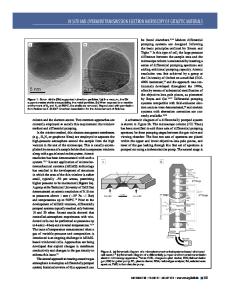Transmission electron microscopy with in situ ion irradiation
- PDF / 311,626 Bytes
- 8 Pages / 584.957 x 782.986 pts Page_size
- 30 Downloads / 539 Views
e macroscopic properties of materials exposed to irradiation are determined by radiation damage effects which occur on the nanoscale. These phenomena are complex dynamic processes in which many competing mechanisms contribute to the evolution of the microstructure and thus to its end-state. To explore and understand the behavior of existing materials and to develop new technologies, it is highly advantageous to be able to observe the microstructural effects of irradiation as they occur. Transmission electron microscopy with in situ ion irradiation is ideally suited to this kind of study. This review focuses on some of the important factors in designing this type of experiment including sample preparation and ion beam selection. Also presented are a brief history of the development of this technique and an overview of the instruments in operation today including the latest additions.
I. INTRODUCTION
Contributing Editor: Khalid Hattar a) Address all correspondence to this author. e-mail: [email protected] DOI: 10.1557/jmr.2014.384
selector to deflect the electrons away from the sample whilst not causing significant deviation of any ions. After an hour with the electron beam and coils turned on, a previously virgin sample was found to contain the same black-spot damage despite the electron beam having been deflected away by the coils. In another test, two gold samples were loaded above and below each other such that ions would be stopped in the top foil but with electrons able to pass through both foils. The objective lens could be used to form a TEM image of either the top or bottom sample. The radiation damage was observed in the top sample with very little in the bottom sample. Pashley and Presland concluded that the “direct observation of ion damage in the electron microscope thus represents a powerful means of studying radiation damage”1 and the technique of TEM with in situ ion irradiation was born. The story now moves to Canada and the Chalk River Nuclear Laboratories in the mid-1960s. Howe et al.2–5 used another Siemens Elmiskop I with an electron filament coated so as to enhance the flux of O ions. Their experiments on radiation damage in copper, gold, and aluminum below 30 K were also the first experiments to combine low temperature and ion irradiation with in situ TEM. In another first, a Faraday cup was installed to allow measurement of the ion beam flux within the microscope column.4 Later in the same decade came the first TEM to be interfaced with an external ion-accelerator in the laboratories of the Atomic Energy Research Establishment at Harwell (UK).6,7 This instrument consisted of a JEOL JEM-6A connected to a 120 kV heavy-ion accelerator and featured electrostatic deflection on the outside of the TEM column to achieve an angle of 35° between the electron and ion beams. This facility was later upgraded to a JEOL JEM-200A in the early 1970s.8
1214
Ó Materials Research Society 2015
Transmission electron microscopy (TEM) with in situ ion irradiation can give invaluable insights into the response of material
Data Loading...











